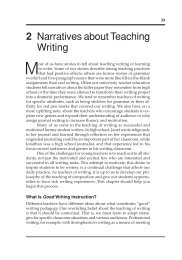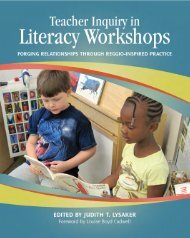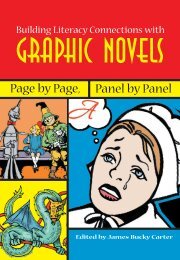Wood_cover.qxd (Page 1) - National Council of Teachers of English
Wood_cover.qxd (Page 1) - National Council of Teachers of English
Wood_cover.qxd (Page 1) - National Council of Teachers of English
- No tags were found...
Create successful ePaper yourself
Turn your PDF publications into a flip-book with our unique Google optimized e-Paper software.
78 Chapter 4throwing a snowball from each hand.I was hit, shot with a cold pain that broke throughthree layers <strong>of</strong> clothes.Our war lasted for hours.Brothers, sister, and neighborhood friendsrecruited to die on the field beforegoing inside for hot chocolate and cartoons.Classroom Snapshot: When I asked students to share their memorypieces, I was most interested in helping them understand how theirmemories developed. How did Cameron, the student who wrote“Winter in Kansas,” remember details about the day she had a snowballfight in Kansas? What kinds <strong>of</strong> memories were most vivid tothem? Most <strong>of</strong> the students in my class said that they rememberedthings best that affected them emotionally. For example, one <strong>of</strong> mystudents wrote about the day he broke his arm, while someone elsewrote about the best birthday present she ever received. I wanted mystudents to think about why they might be more apt to remembersomething like what it was like getting their first pets rather than whatthey learned in one <strong>of</strong> their classes in elementary school. This discussioneasily led to the next activity—learning about how memoryworks in the brain.Research: Learning about the BrainStart by showing students the following Web site—www.exploratorium.edu/memory/—and giving them a few minutes to click aroundand learn a little bit about the brain in relation to memory. Once theyhave had a chance to look at the Web site freely, put the questions inFigure 4.2 on an overhead and have students work in groups <strong>of</strong> threeor four to answer the questions on paper. Most <strong>of</strong> the answers can befound in the section <strong>of</strong> the Web site called “Sheep Brain Dissection” andother parts <strong>of</strong> the Exploratorium Web site, but students may have tosearch other sites to learn about mnemonic devices.Once the class has compiled as much as they can about howmemory works in the brain, they are ready to read the poem “Mnemonic.”Reading: Filling in the GapsIn Li-Young Lee’s poem “Mnemonic,” the speaker remembers a momentwhen his father gave him a blue sweater to keep him warm. He remem-
















